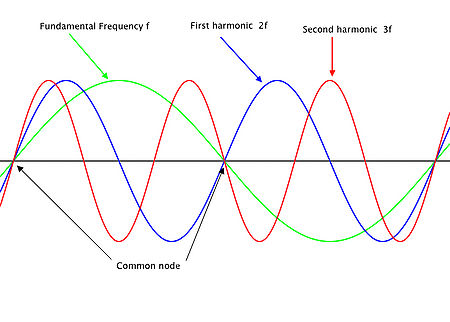Harmonics: Difference between revisions
(added brief info and diagram - diagram needs improvement by someone with a better drawing program than me. Please!) |
mNo edit summary |
||
| Line 9: | Line 9: | ||
In the diagram below it can be seen that harmonics share common nodes. | In the diagram below it can be seen that harmonics share common nodes. | ||
(the diagram | (the diagram needs improvement by someone with a better drawing program and skills than I have - any takers? Thanks Tim R ) | ||
[[Image:Vk4yeh_harmonics.jpg |450px]] | [[Image:Vk4yeh_harmonics.jpg |450px]] | ||
Revision as of 15:11, 22 August 2008
Related wiki pages: Antennas, Propagation, Interference, Gain, SWR
What is an harmonic?
An harmonic of a particular frequency (the fundamental frequency f) is another frequency that is an integer multiple of the first one. For example:
if f = 125MHz, the harmonics would be: 2f = 250MHz, 3f = 375MHz, 4f = 500MHz ..... etc
In the diagram below it can be seen that harmonics share common nodes.
(the diagram needs improvement by someone with a better drawing program and skills than I have - any takers? Thanks Tim R )
Mathematically, the basic wave equation is:
<math> \mathit{v}=\mathit{f}\times \lambda </math>
v is the velocity of the wave in metres per second - a constant close to the speed of light for radio waves in the atmosphere.
f is the frequency of the wave - how many cycles pass a fixed point per second
<math> \lambda </math> is the wavelength of the wave in metres - the distance between two peaks of the wave.
So, as the frequency increases, the wavelength decreases - a doubling of frequency causes a halving of wavelength etc.
